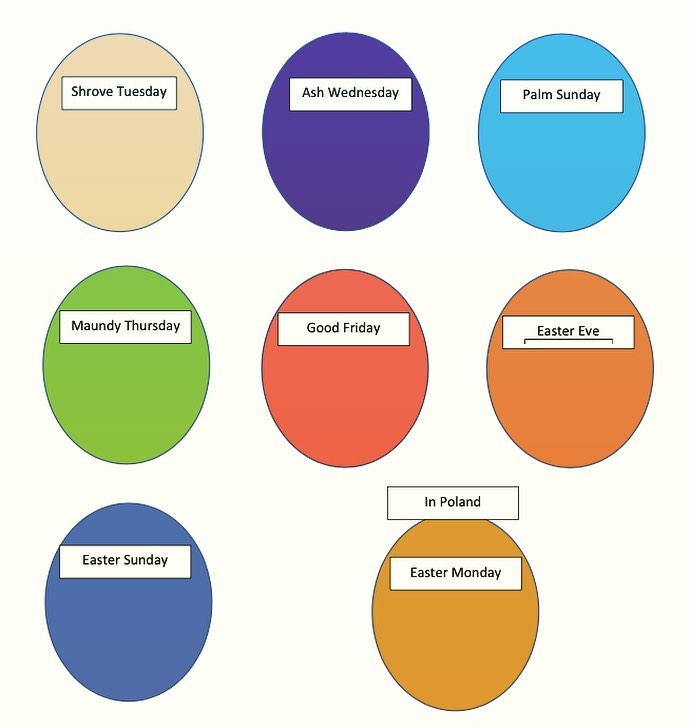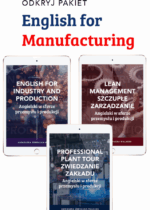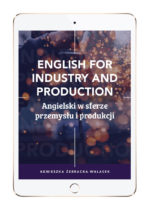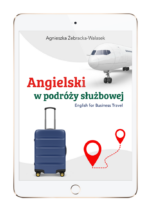Przede wszystkim dziękuję za tak duży odzew dot. lekcji Wielkanocnej. Święta Wielkanocne już pukają do drzwi, a może w tym czasie, usiądziesz spokojnie na kanapie i poczytasz o Wielkanocy po angielsku?
Zapraszam!
Zacznijmy od nazw poszczególnych dni związanych z tym magicznym czasem.

To może teraz szybki Quiz wiedzowy?
Match the days (in eggs) with the words below:
The beginning of Holy Week crucifixion baking hot cross-buns pancakes palm branches the last day of Carnival Resurrection Easter Parade in New York Jesus rode into Jerusalem the beginning of the forty days of Lent Last Supper Queen gives money to the poor playing egg games/ egg hunt throwing water over girls/people
2. Read the text and check your answers.
Możecie sobie wyobrazić pożółkły, pokolorowany przeze mnie, wycięty skrawek papieru z tym właśnie artykułem – pisany chyba na jakieś maszynie lub początkowych komputerach dodany do kolorowanki. Ja jako dziecko (czyli milion lat temat) przerabiałam go w szkole językowej i tak mi się spodobał, że schowałam go sobie do magicznej teczki, którą mam do dziś. Autor nieznany, wybaczcie.
The last day of carnival is called Mardi Gras or Shrove Tuesday. On that day pancakes are the favourite food. There is the International Pancake Race in Liberal (USA) and Olney (England) at the same time. Housewives run a distance of about 415 yards from the market to the church. They have aprons and frying pans in their hands. The winner gets a prayer book. Everything ends with a special service, at which the frying pans and the pancakes lie near the alter. The races started about 500 years ago when a woman who was baking pancakes heard the church bells. She started running to the church, with a frying pan in her hand.
The next day is called Ash Wednesday. It is the beginning of the forty days of Lent. Easter time comes with Palm Sunday – the day which Jesus rode into Jerusalem and people greeted him with palm branches. Palm Sunday begins Holy Week. On Maundy Thursday – the day which commemorates the Last Supper – the British Queen gives Maundy money to the poor.
The Good Friday commemorates the crucifixion (death on the cross) of Jesus. The English bake hot-cross buns on that day. Years ago people thought that hot-cross buns baked on Good Friday had magical powers. People used them as medicine.
The next day is Easter Eve, the Saturday when Christ lay in the tomb. Then comes Easter Sunday, the Day of Christ’s Resurrection. Families gather for Easter dinner of
hard boiled eggs and delicious cakes. In New York people watch the Easter Parade. British and American children play egg games like egg hunt on Easter Sunday. The traditional symbols of Easter are dyed eggs – symbols of a new life, the Easter Lamb – the Risen Christ, the Easter Hare and Easter lilies.
Answer the following questions:
- How did the pancake race start?
- Where can you see the Easter Parade?
- What do they bake on Good Friday?
A jeśli nie macie pojęcia jak wygląda Wielkanoc w UK to obejrzyjmy video! 🙂
To teraz porównajmy Naszą Wielkanoc z Easter!
EASTER IN POLAND vs. EASTER IN ENGLAND
A na koniec koszyczek czyli. Easter Basket.

Source: Pinterest.
What do you put in the Easter basket?
What does your Easter breakfast look like?
Jeśli nie znasz słówek pamiętaj o słowniku, choćby: www.diki.pl
A na koniec Quizlet dla zabawy! A co mi tam!
Kliknijcie poniżej:
https://quizlet.com/_8a9b4u?x=1jqt&i=zs904
Happy Easter kochani!
Wasza Angielski na szpilkach




